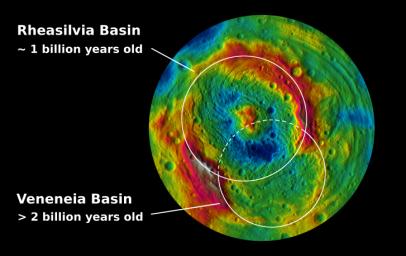
|
South Polar Impacts
- Click the image above for a larger view
- Full-Res JPEG (2728 x 1717) (386.6 kB)
- Full-Res TIFF (2728 x 1717) (14.1 MB)
Caption:

Unannotated Version
Click on the image for larger view
Download the full resolution unannotated TIFF
This topographic map from NASA's Dawn mission shows the two large impact basins in the southern hemisphere of the giant asteroid Vesta. The map is color-coded by elevation, with red showing the higher areas and blue showing the lower areas. Rheasilvia, the largest impact basin on Vesta, is 310 miles (500 kilometers) in diameter. Scientists estimate that it formed 1 billion years ago by counting the number of smaller craters that have formed on top of it. The other basin, Veneneia, is 250 miles (400 kilometers) across and lies partially beneath Rheasilvia. Scientists estimate that Veneneia is at least 2 billion years old.
The topography was derived from images taken by Dawn's framing camera during Dawn's high-altitude mapping orbit, which averaged about 420 miles (680 kilometers) in altitude and took place from Sept. 30 to Nov. 2, 2011. The resolution during that orbit was about 200 feet (60 meters) per pixel.
Background Info:
The Dawn mission to Vesta and Ceres is managed by NASA's Jet Propulsion Laboratory, a division of the California Institute of Technology in Pasadena, for NASA's Science Mission Directorate, Washington. UCLA is responsible for overall Dawn mission science. The Dawn framing cameras were developed and built under the leadership of the Max Planck Institute for Solar System Research, Katlenburg-Lindau, Germany, with significant contributions by DLR German Aerospace Center, Institute of Planetary Research, Berlin, and in coordination with the Institute of Computer and Communication Network Engineering, Braunschweig. The framing camera project is funded by the Max Planck Society, DLR and NASA/JPL.
More information about Dawn is online at http://www.nasa.gov/dawn and http://dawn.jpl.nasa.gov .
Cataloging Keywords:
| Name | Value | Additional Values |
|---|---|---|
| Target | 4 Vesta | |
| System | Main Belt | |
| Target Type | Asteroid | |
| Mission | Dawn | |
| Instrument Host | Dawn | |
| Host Type | Orbiter | |
| Instrument | Framing Camera (FC) | |
| Detector | ||
| Extra Keywords | Color, Crater, Impact, Map | |
| Acquisition Date | ||
| Release Date | 2012-05-10 | |
| Date in Caption | 2011-11-02 | |
| Image Credit | NASA/JPL-Caltech/UCLA/MPS/DLR/IDA/PSI | |
| Source | photojournal.jpl.nasa.gov/catalog/PIA15665 | |
| Identifier | PIA15665 | |
